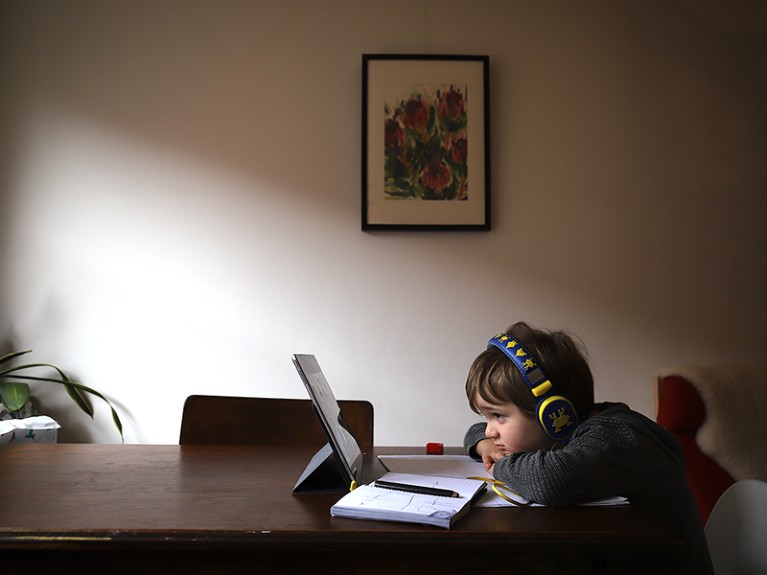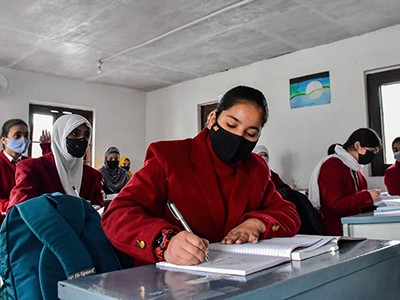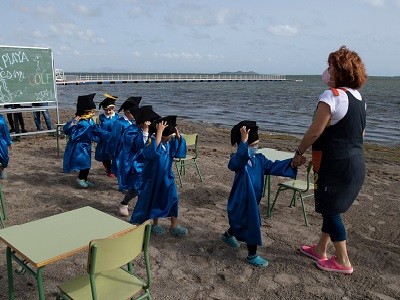
COVID-19 disruptions forced schools to innovate.Credit: David Gray/Getty
One of the most shocking impacts of the COVID-19 pandemic has nothing to do with infections or health. It is that school closures have damaged the education of some 1.6 billion children around the world.
Two years into the pandemic, schools had been completely closed for an average of more than 4.5 months across countries. One in ten countries had closed schools for more than nine months, according to the United Nations cultural organization UNESCO, and millions of children around the world had not gone back at all. Data are still coming in, but they are starting to confirm what everyone feared: that the children facing the biggest setbacks in learning are those who are poor or otherwise disadvantaged. And it is well established that learning losses leave lifelong scars, so it is likely that this will lead to lost opportunities and lower incomes for decades to come.
Many nations want to minimize these losses, but returning schools to business as usual would be a mistake. Instead, they should use this moment to improve teaching and education systems, informed by research. As a Feature published today makes clear, researchers have built up large bodies of evidence, including randomized controlled trials, that point to cost-effective methods of improving school attendance and learning in both low- and high-income countries. These strategies range from providing information to parents and children about the long-term benefits of education, to helping children comprehend what they read, involving parents in children’s education, giving children meaningful feedback on their work and helping students to plan and evaluate their own learning.
The pandemic derailed learning for 1.6 billion students. Here’s how to help them catch up
Too often, such research is overlooked by educators and ignored by policymakers who mistakenly think they know what works best. But putting evidence-based insights to work in classrooms around the world would help children to recover from the educational damage inflicted by the pandemic. It would also strengthen entire education systems, many of which were failing children well before COVID-19 struck. Many children are denied education by conflict, poverty or politics, including crises such as the war in Ukraine and the Taliban’s decision to exclude many girls from school in Afghanistan.
Proponents of evidence-informed education have to be realistic about the limitations of research. One big challenge is the huge variation in classrooms and schools within countries and around the world. A tutoring programme shown to be effective at one school might not work at another if the children’s ages, learning styles or home environments differ, or if it is implemented in a different way. Educational research tends to serve as a guide — but it is not a guarantee that something will work for a particular classroom or child, or when scaled up across a nation. It’s therefore invaluable for teachers to be fully involved in research and in applying results.
A bigger problem is that education research is largely decoupled from practice: most educational researchers do not teach; most teachers do not learn about, or take part in, much research. (Compare this to medicine, in which practitioners — doctors — generally learn about research when they train and consult evidence-based guidelines when they practise, and might conduct research themselves.) However, this is not the same everywhere. Researching the effectiveness of lessons is an integral part of teachers’ professional development in countries including China and Japan. Other nations should learn from this approach.
Beyond this, there is a growing body of evidence showing how best to get research insights into the classroom. A top-down approach that forces new methods on educators doesn’t generally succeed. A better way, argues Rukmini Banerji, who leads Pratham, an educational non-governmental organization in New Delhi, is to encourage teachers and students to try out evidence-backed approaches for themselves.
Learn from disruption
In some cases, the disruption caused by COVID-19 introduced fresh ways of thinking and working in education — as difficult as those changes have been. Schools invented ways of delivering lessons digitally, teachers became more involved in children’s social and emotional health, and parents became engaged in what their children were learning at home. Unfortunately, the impact of these innovations hasn’t been well studied, because they happened so fast. Researchers and schools should make the most of the data they can collect and, where possible, gather more, so that they can hold on to innovations that helped — both to assist children now and to strengthen education overall.
COVID and schools: the evidence for reopening safely
It’s also important to track cohorts of children to expose the lasting impacts of missed schooling, as well as other consequences of the pandemic. And where innovations and catch-up programmes are in place, their impact should be measured with rigorous research, so that these data are available when learning is next upended.
Some have suggested that children might be able to bounce back quickly from COVID-related school closures by putting on a learning spurt. A more realistic view is that the better-off children will recover quickest, and the pandemic will amplify existing deep inequalities in education. That’s why any efforts to help children today — and build the education systems of tomorrow — must focus on the most marginalized and disadvantaged children first.

 The pandemic derailed learning for 1.6 billion students. Here’s how to help them catch up
The pandemic derailed learning for 1.6 billion students. Here’s how to help them catch up
 The COVID generation: how is the pandemic affecting kids’ brains?
The COVID generation: how is the pandemic affecting kids’ brains?
 COVID and schools: the evidence for reopening safely
COVID and schools: the evidence for reopening safely
 How COVID is changing the study of human behaviour
How COVID is changing the study of human behaviour





